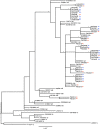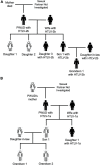Spread of Human T-Lymphotropic Virus 1 and 2 Among Relatives of People Who Use Illicit Drugs in Northern Brazil
- PMID: 35722295
- PMCID: PMC9205188
- DOI: 10.3389/fmicb.2022.889948
Spread of Human T-Lymphotropic Virus 1 and 2 Among Relatives of People Who Use Illicit Drugs in Northern Brazil
Abstract
The human T-lymphotropic virus 1 (HTLV-1) and 2 (HTLV-2) can be transmitted between humans by mechanisms associated with horizontal and vertical routes. Recently, high prevalence rates and levels of genetic diversity for HTLV-1 and HTLV-2 were detected among people who use illicit drugs (PWUDs) in the Brazilian state of Pará. None of the PWUDs with HTLV-1 or HTLV-2 were aware of their carrier condition of the retrovirus, and they ability to spread it to their family group, sexual partners, and other contacts. Thus, this study evaluated the presence of HTLV-1 and HTLV-2 in families of PWUDs in the state of Pará, in Northern Brazil. This descriptive study used convenience sampling and accessed 37 PWUDs and their respective families (n = 97) in 18 municipalities in the state of Pará, northern Brazil. All participants provided personal data and were tested for the presence of HTLV-1 and HTLV-2 using enzyme-linked immunosorbent assay and western blotting. HTLV positive samples were selected for Nested-PCR, and viral genotyping by nucleotide sequencing and phylogenetic analysis. HTLV-1 or HTLV-2 infections were detected in 15 families of PWUDs: 27 family members of PWUDs were infected with HTLV-1 (27.8%) and another 20 of them with HTLV-2 (20.6%). Subtypes 1a [subgroup A (54.5%)], 2b (20.5%), and 2c (25.0%) were detected. High horizontal (76.9%) and vertical (61.4%) transmission rates of HTLV were ascertained. Factors that facilitate the acquisition and transmission of HTLV-1 and HTLV-2 were reported by the participants, such as long-term relationships, unprotected sex, breastfeeding, and lack of knowledge about the condition of being a carrier of the retrovirus. Evidence indicates intrafamilial transmission of HTLV from PWUDs to members of their respective families. Key interventions should urgently be employed for the control and prevention of HTLV-1 and HTLV-2 to reduce the spread of this retrovirus in PWUDs and the general population in Northern Brazil and elsewhere.
Keywords: Brazil; HTLV; epidemiology; intrafamilial transmission; prevention; public health strategies; use of illicit drugs.
Copyright © 2022 Oliveira-Filho, Frade, Fonseca, Sawada, Martins, Machado, Vallinoto, Ishak, Lemos, Fischer and Kupek.
Conflict of interest statement
The authors declare that the research was conducted in the absence of any commercial or financial relationships that could be construed as a potential conflict of interest.
Figures




Similar articles
-
Human T-lymphotropic virus 1 and 2 among people who used illicit drugs in the state of Pará, northern Brazil.Sci Rep. 2019 Oct 14;9(1):14750. doi: 10.1038/s41598-019-51383-7. Sci Rep. 2019. PMID: 31611600 Free PMC article.
-
Epidemiological and molecular evidence of intrafamilial transmission through sexual and vertical routes in Bahia, the state with the highest prevalence of HTLV-1 in Brazil.PLoS Negl Trop Dis. 2023 Sep 28;17(9):e0011005. doi: 10.1371/journal.pntd.0011005. eCollection 2023 Sep. PLoS Negl Trop Dis. 2023. PMID: 37769013 Free PMC article.
-
Hepatitis B Virus Infection among People Who Use Illicit Drugs: Prevalence, Genotypes and Risk Factors in the State of Amapá, Northern Brazil.Subst Use Misuse. 2020;55(10):1633-1639. doi: 10.1080/10826084.2020.1756334. Epub 2020 Apr 27. Subst Use Misuse. 2020. PMID: 32338560
-
Vertical transmission of HTLV-I/II: a review.Rev Inst Med Trop Sao Paulo. 1998 Jul-Aug;40(4):245-51. doi: 10.1590/s0036-46651998000400008. Rev Inst Med Trop Sao Paulo. 1998. PMID: 9876439 Review.
-
The challenge of describing the epidemiology of HTLV in the Amazon region of Brazil.Retrovirology. 2020 Feb 14;17(1):4. doi: 10.1186/s12977-020-0512-z. Retrovirology. 2020. PMID: 32059740 Free PMC article. Review.
Cited by
-
Intrafamilial Transmission of HTLV-1 and HTLV-2 in Indigenous Peoples of the Brazilian Amazon: Molecular Characterization and Phylogenetic Analysis.Viruses. 2024 Sep 26;16(10):1525. doi: 10.3390/v16101525. Viruses. 2024. PMID: 39459860 Free PMC article.
-
Syphilis and Co-Infections with HIV-1, HBV, and HCV among People Who Use Crack-Cocaine in Northern Brazil.Pathogens. 2022 Sep 16;11(9):1055. doi: 10.3390/pathogens11091055. Pathogens. 2022. PMID: 36145487 Free PMC article.
-
Molecular and Phylogenetic Evidence of Interfamilial Transmission of HTLV-1 in the Afro-Descendant Community of São José de Icatú in the Brazilian Amazon.Viruses. 2024 Aug 13;16(8):1290. doi: 10.3390/v16081290. Viruses. 2024. PMID: 39205264 Free PMC article.
References
-
- Abreu I. N., Lopes F. T., Lima C., Barbosa A., de Oliveira L. R., Fujishima M. A., et al. (2022). HTLV-1 and HTLV-2 Infection Among Warao Indigenous Refugees in the Brazilian Amazon: Challenges for Public Health in Times of Increasing Migration. Front. Public Health 10:833169. 10.3389/fpubh.2022.833169 - DOI - PMC - PubMed
-
- Alcantara L. C., Shindo N., Van Dooren S., Salemi M., Costa M. C., Kashima S., et al. (2003). Brazilian HTLV type 2a strains from intravenous drug users (IDUs) appear to have originated from two sources: Brazilian Amerindians and European/North American IDUs. AIDS Res. Hum. Retrovir. 19 519–523. 10.1089/088922203766774577 - DOI - PubMed
LinkOut - more resources
Full Text Sources

